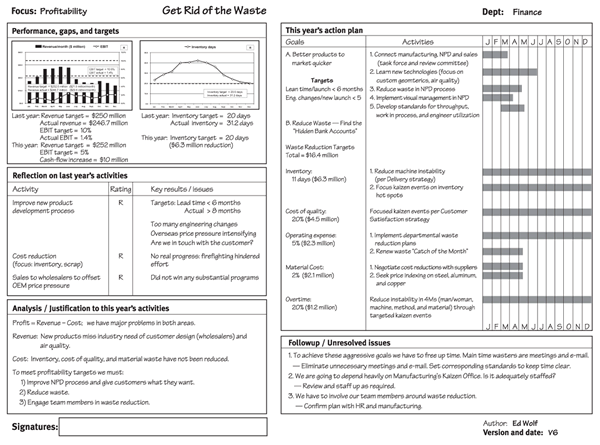Strategy Deployment
A management process that aligns—both vertically and horizontally —an organization’s functions and activities with its strategic objectives. A specific plan—typically annual—is developed with precise goals, actions, timelines, responsibilities, and measures.
The example A3 below shows the strategy of a finance department director for returning a company to profitability (Dennis 2006, p.103). The Performance box in the upper left corner illustrates that the company missed its revenue and EBIT targets the previous year. It also shows inventory levels because the director considers it to be the company’s biggest waste and a serious drag on cash flow. The “R” for “red” rating in the Reflection box shows that key improvement efforts didn’t work last year. The Analysis below it shows the top actions that must be done to achieve this year’s strategic objective of profitability. The Action Plan on the right provides the who, what, when, where, and how of the strategy. The Followup box displays any lingering concerns and how the director will check on progress.
Strategy deployment, also known by the Japanese term hoshin kanri, may start as a top-down process when an organization launches a lean conversion. However, once the major goals are set, it should become a top-down and bottom-up process involving a dialogue between senior managers and project teams about the resources and time both available and needed to achieve the targets. This dialogue often is called catchball (or nemawashi) as ideas are tossed back and forth like a ball.
The objective is to match available resources with desirable projects so that only projects that are desirable, important, and achievable are authorized. (This is to avoid the practice in many organizations of embarking on many improvement initiatives that are popular in parts of the organization but aren’t completed for lack of cross-function agreement and resources).
As an organization progresses with its lean transformation and gains experience with policy deployment, the process should become much more bottom-top-bottom, with each part of the organization proposing actions to senior management to improve performance. A mature lean organization may call this process strategy alignment or policy management. (Adapted from Dennis 2006.)
